
How Content Marketing Directly Improves Sales
Businesses have a wealth of options for promoting their solutions to boost sales. While some invest a tremendous amount of money in traditional advertising channels, many use the power of content instead. Content marketing directly improves sales in many ways, and typically costs much less and has higher returns than ads.
If your company isn’t harnessing the potential of content marketing, then you could be losing valuable opportunities to attract, interest, and convert buyers. If you haven’t shifted to an all-in perspective on content, you’ll want to know about these proven ways that content supports sales and leads to higher profitability.
Quick Takeaways:
- B2B buyers are changing; they seek out more informational and educational content to solve problems.
- Content marketing provides a path for buyers to consume content, moving them toward a conversion.
- You’re more likely to sell a solution with the right content than with aggressive sales tactics.
- Mapping out content for each stage of the buyer’s journey makes it easier for content to do its job and for you to increase sales.
We Live in a Digital Marketplace
Even before the pandemic forced most businesses to operate virtually, we were already living in a digital landscape. The B2B buyer has been evolving for some time, choosing to investigate and research on their own before ever initiating contact with sales. This means you must adapt to the new reality and understand the interests and motivations of your B2b buyer persona more than ever.
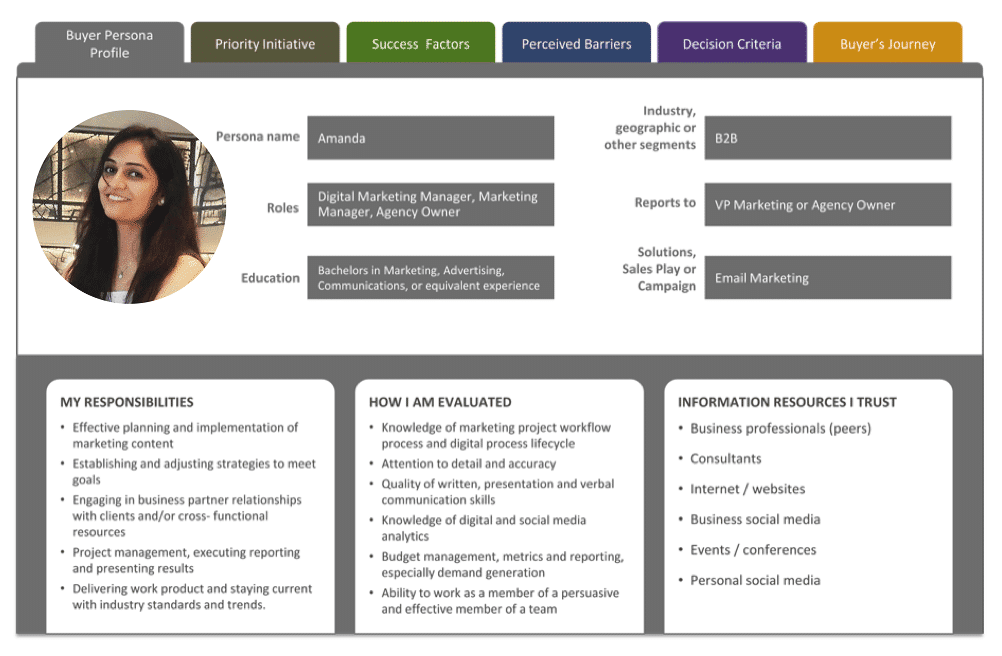
Here’s a handy list of the attributes of today’s B2B buyer:
Millennials Rule
Millennials now make up the largest percentage of the U.S. workforce. They are digital natives and don’t want to be sold anything. They will consume content, but only if it’s valuable to them.
Information Is More Accessible
They have more access to information than ever before. Admittedly, it was much harder to make B2B sales decades ago. It required lots of interaction between sales and buyers.
Now, you can find the answer to anything in seconds. Understanding that information is readily available also reinforces the need to produce content that ranks consistently.
Buying Decisions Involve Diverse Stakeholders
Buying decisions include a more diverse group. Previously, these decisions may have been under the supervision of procurement and a department head that would use the product or service.
Currently, decisions include more stakeholders from a variety of departments. We usually call these people influencers. They may not have the final say, but their opinion counts. You must consider all these influencers when creating content that leads to sales.
B2B Buying Isn’t Linear
It would be great if the path were straight and constant. However, that’s not what usually happens. Throwing a pandemic into the mix means this statement is even more true now.
Buyers may take two steps forward then three back because priorities change. This situation is of importance because it affects how you nurture prospects. Even if you think a buyer is ready to say yes, they may regress, so you have to be ready to keep them on the hook with impactful content.
The Pillars of Content Marketing and How They Improve Sales
If you look at the pillars of content marketing, it’s easy to draw the line between its performance and increasing sales.
Build a Content Strategy
Every content marketing initiative must start with a content strategy. This is your content bible. It outlines your goals, key messaging, buyer personas, and more. Is a content strategy necessary for improving your sales? YES. Without it, you are rudderless and won’t see the results you expect because you’re just throwing things to the wall and hoping they stick.
Define Clusters and Topics
In the content strategy you’ll create your content clusters, which are the main categories of content. From there, you develop topic ideas, influenced by industry trends, buyer needs, keywords, and product roadmaps.
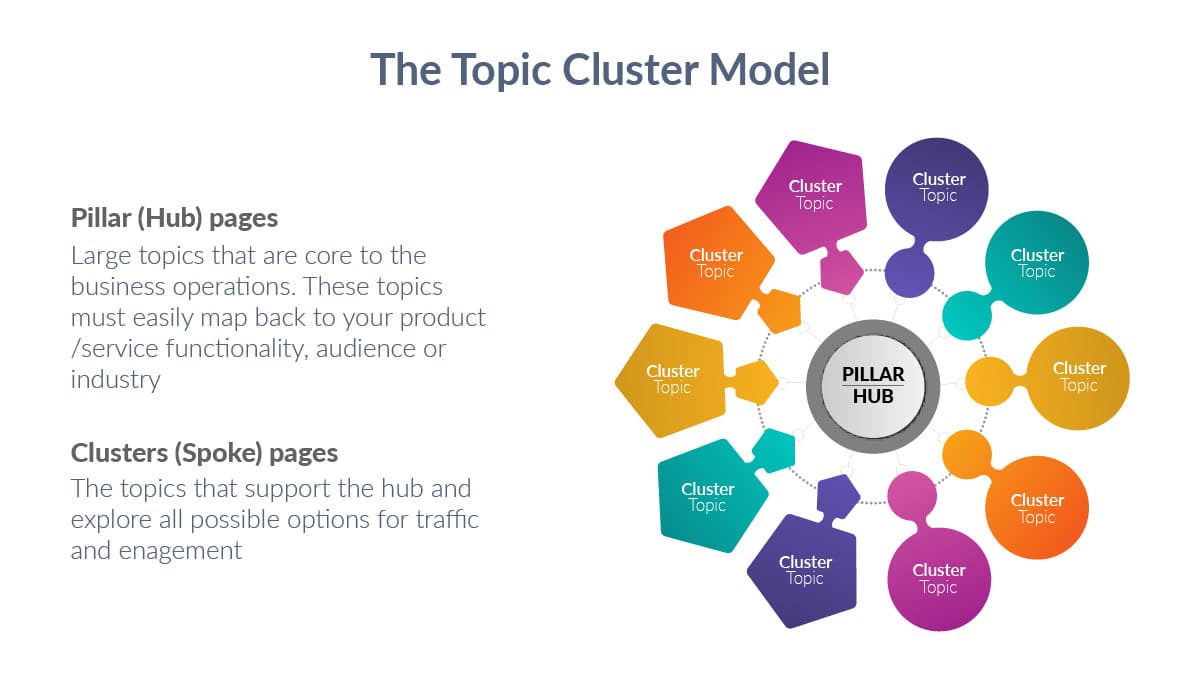
Do Your Research
Then comes the research. This is where you dig deep to understand your buyer intimately and the landscape. Who is your competition? Not just direct competitors but also content competitors (i.e., industry groups and publications).
Develop a Content Calendar and Commit to a Cadence
You’ll put all this together into a content calendar and commit to a cadence of publishing. How many blogs should you write a month? There’s no absolute answer. However, research on blog frequency suggests that the magic number is 11.
If that sounds like something unattainable because you don’t have the bandwidth, there’s a solution for that. Blog writing services are a smart option (more on outsourcing later).
Pillars in Place? What Kind of ROI Can You Expect?
Content marketing ROI (return on investment) isn’t a mystery. It’s very easy to measure its performance and how it contributes to sales. Many companies get hung up on this, especially if they see ROI in terms of ad metrics like impressions and clicks. (These are actually pretty meaningless by the way.)
The type of ROI you can expect from content marketing is more tangible in terms of how it improves sales.
Conversions
How does each piece of content contribute to conversions? There are multiple conversions that occur in the buyer’s journey. You get an email opt-in from a newsletter subscription, or someone completes a form to download a whitepaper. These are all trackable, and you can follow the progress of the buyer with marketing automation tools that score activities.
Content marketing can skyrocket your conversions and improve their quality. If you depend on search or digital ads to deliver conversions, your results probably aren’t stellar. Lots of spam and unqualified leads enter your CRM (customer relationship management) platform. Content marketing conversions are, in most cases, more qualified, and they have a genuine interest in your solutions.
Conversion quality is a high priority for companies, with 48% of survey respondents naming it as their most popular one. Quality of conversions links to the quality and consistency of your content. You must improve one to improve the other.
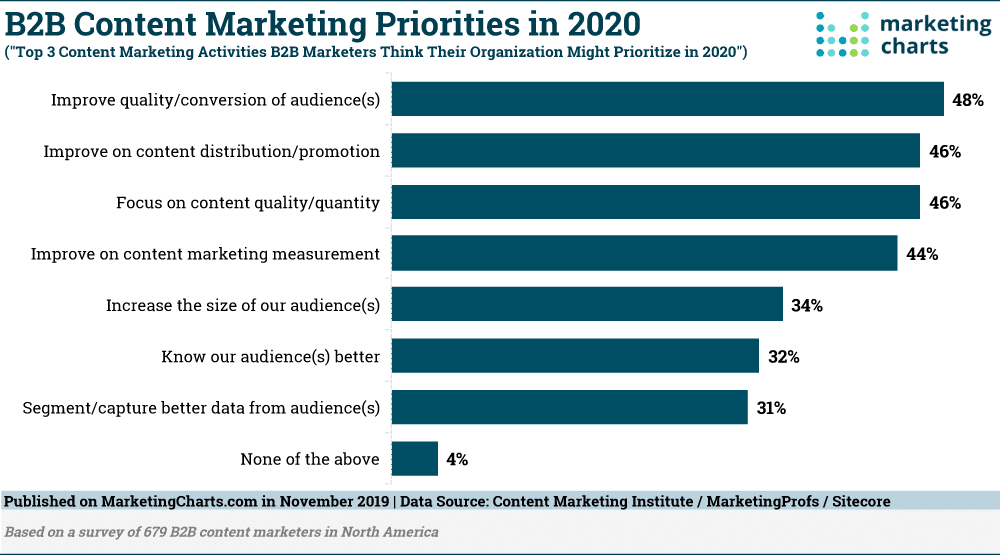
Ranking Visibility
Do you track your ranking for key search terms? Do you know what and how you rank? If you aren’t creating consistent content, it’s hard to compete. Content marketing makes all the difference. It can dramatically lift your organic rank if the content uses the right keywords, is relevant to the audience, is of high quality, and is distributed across many channels.
Here’s the real difference between content marketing and paid search ads. Your content—blogs, videos, etc.—will continue to bring value in organic rankings as long as it’s live. Ads are short-term and only bring value while you’re paying for them. After the campaign ends, there’s no incremental ROI.
If you want to rank, which is a core tenet of content marketing, you must be a publishing machine.
Lead Source
Every lead starts somewhere. Those sources may have been cold calls or advertisements in a publication in traditional sales and marketing models. Well, in 2020, buyers don’t answer the phone if they don’t know you. They also do a great job of being ad blind.
An eye-tracking study from Nielsen discovered that viewers disregard global navigation because they associate it with ads. The research also revealed that users dismiss non-ad content that’s close to the typical ad areas. We learned this behavior because we grew tired of constant ads and ignore them because we don’t believe they have value.

It’s no longer realistic to count these as probable lead sources. Instead, you’re more likely to find content marketing as the source. You attract leads by creating search-friendly content. Then, you continue to engage them once they provide their email address. You’re building a relationship through content, not through ads or sales.
It’s a dramatic shift, but one that directly improves sales. You’re not selling them anything. You’re telling them stories, offering answers, and earning their trust. To do this well, you’ll need content for every stage of the buyer, which we’ll address next.
Content Mapping to the Buyer’s Journey
Every piece of content you create should align with a stage of the buyer’s journey. When you do this well, it makes selling easier. That’s because you are well aware of the needs, motivations, and influences for each stage.
While each stage is critical, most content lands in the top-of-the-funnel (TOFU). Content Marketing Institute’s (CMI) 2020 B2B Content Marketing Report found that 50% of content is TOFU. As the customer continues down the funnel, the percentages decrease.
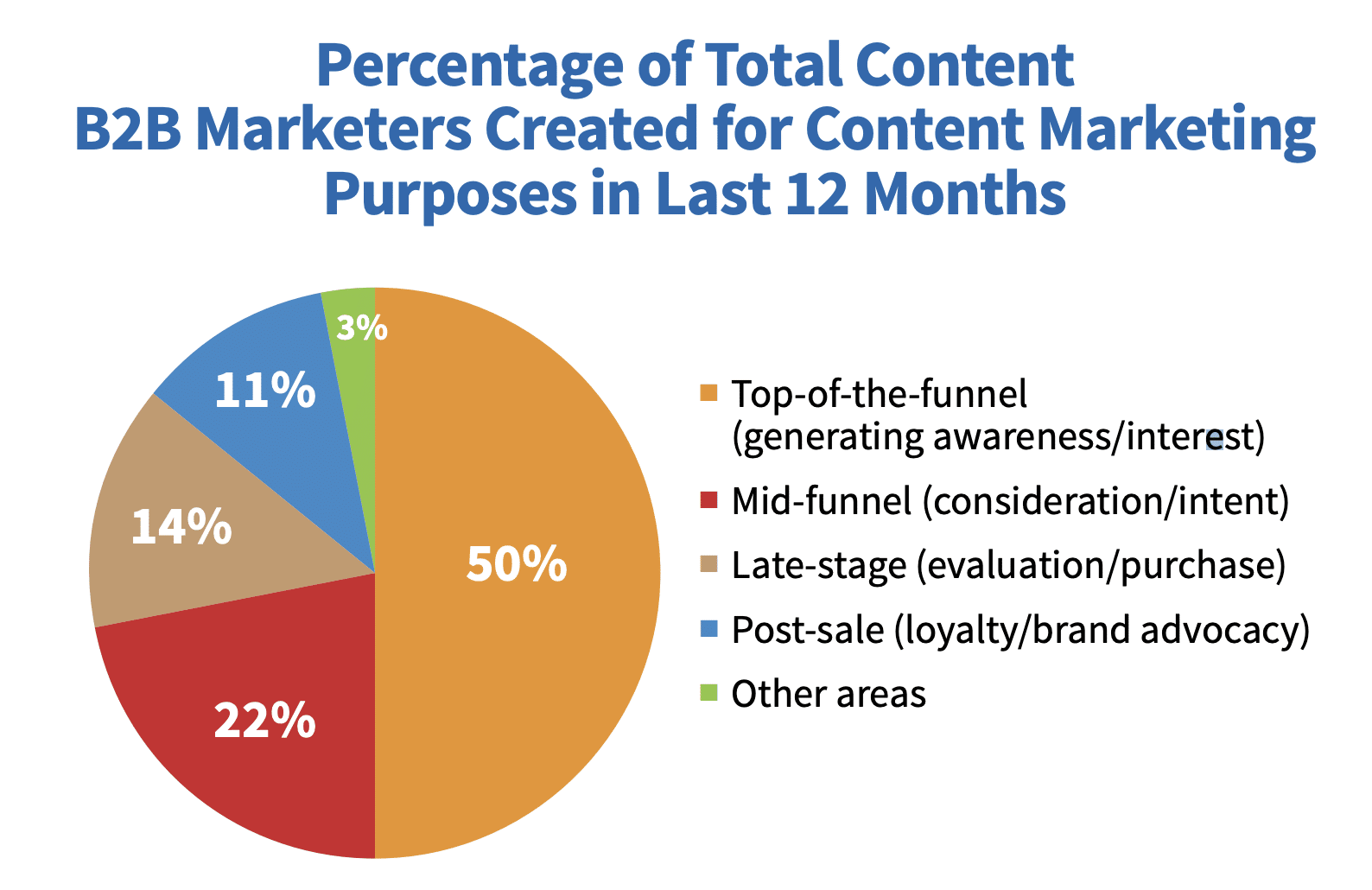
Ideally, you want to have a balance. It may seem practical to focus on TOFU content because it generates new leads, and you can attract them with well-optimized content that they find through search.
However, just because you attract them doesn’t mean you convert them. B2B buyers, on average, consume around 13 pieces of content during the journey, per a survey report from FocusVision. The majority of that content (70%) is directly from your website. Thus, you need a full library of materials to fulfill this need.
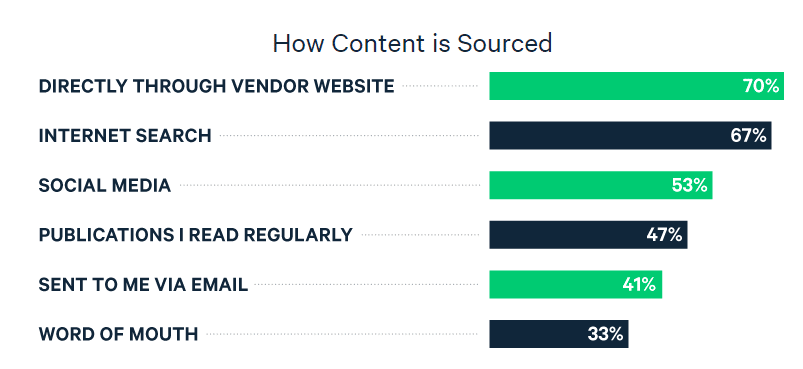
Content Plays Different Roles Throughout the Journey
For content to be effective and directly impact sales, content mapping is essential. You have to be aware that content plays different roles in the journey. Right now, you don’t really know what type of content influences a sale, but you can look at content marketing tenets around content mapping to get a grasp of what works for each stage.
- TOFU content is about awareness. Buyers are trying to understand their challenges and possible solutions. Content for this stage focuses a lot on SEO optimization and isn’t salesy. It’s educational and an opportunity for the buyer to realize your expertise and to build trust.
- Middle-of-the-funnel (MOFU) content focuses on consideration. The buyer has clarity around their problem and is narrowing down the options. This content needs to drive home how you solve their challenges better than competitors can, emphasizing what matters to them.
- Bottom-of-the-funnel (BOFU) content is the finish line. Your buyer is ready to make a decision. What will sway them? The most potent pieces of content for purchase decisions, according to the FocusVision survey, are product specs and functionality, product comparisons, success stories, content that defines value for internal stakeholders, tutorials, and guidance.
Content Is Your New Sales Team
The right balance of content and making it accessible to your audience is the new way to sell. As you can see, buyers self-direct their own journey. Only when they come to the consideration and decision stages will they want to engage sales.
It’s possible they never will. Remember, your B2B buyer changed. He or she is more likely to be a millennial and a digital native. They expect it to be frictionless to buy your product, whether it’s a physical product like machinery or a software app.
Let them explore and learn on their own. If your content does the job and guides buyers down the funnel as designed, buyers will connect with sales on their terms.
Overcoming Challenges: How to Win at Content Marketing without Exhausting Your Budget
One of the biggest hurdles that any company faces in executing content marketing is a lack of resources. Without dedicated content creators, it’s impossible to publish high-quality content that leads to more sales consistently.
Many businesses are figuring out they can’t do it alone, with 49% outsourcing content marketing. By partnering with content marketing experts, you’ll have access to on-demand talent that can fulfill your commitment to publishing a certain amount of content each month.
CMOs state their biggest issue with developing effective content is a lack of budget to scale.
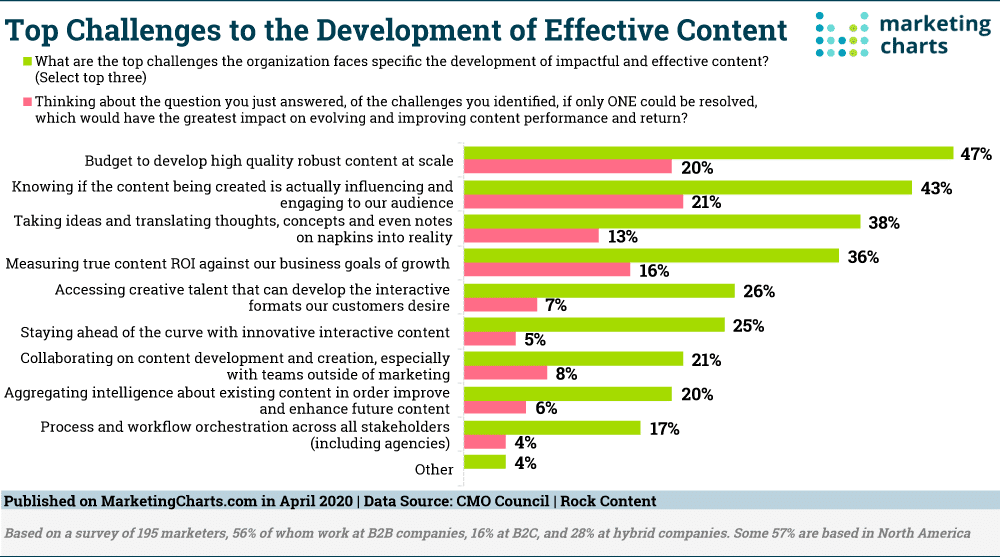
The budget quandary is solvable with an outsourcing model. You aren’t adding full-time employees, which require salaries, benefits, and more. Instead, outsourcing with a professional agency is much more cost-effective, and there’s no additional time to ramp up. You’re dealing with experts at content marketing that can quickly begin producing content that ranks and converts.
Content Marketing Made Easy with Our Content Builder Service
If you are ready to get more traffic to your site with quality content published consistently, check out our Content Builder Service.
Set up a quick consultation, and I’ll send you a free PDF version of my books. Get started today and generate more traffic and leads for your business.



![Understanding the Stages of Your Sales Funnel [Infographic]](https://marketinginsidergroup.com/wp-content/uploads/2023/09/Screenshot-2023-07-11-at-10.59.54-AM.png)


